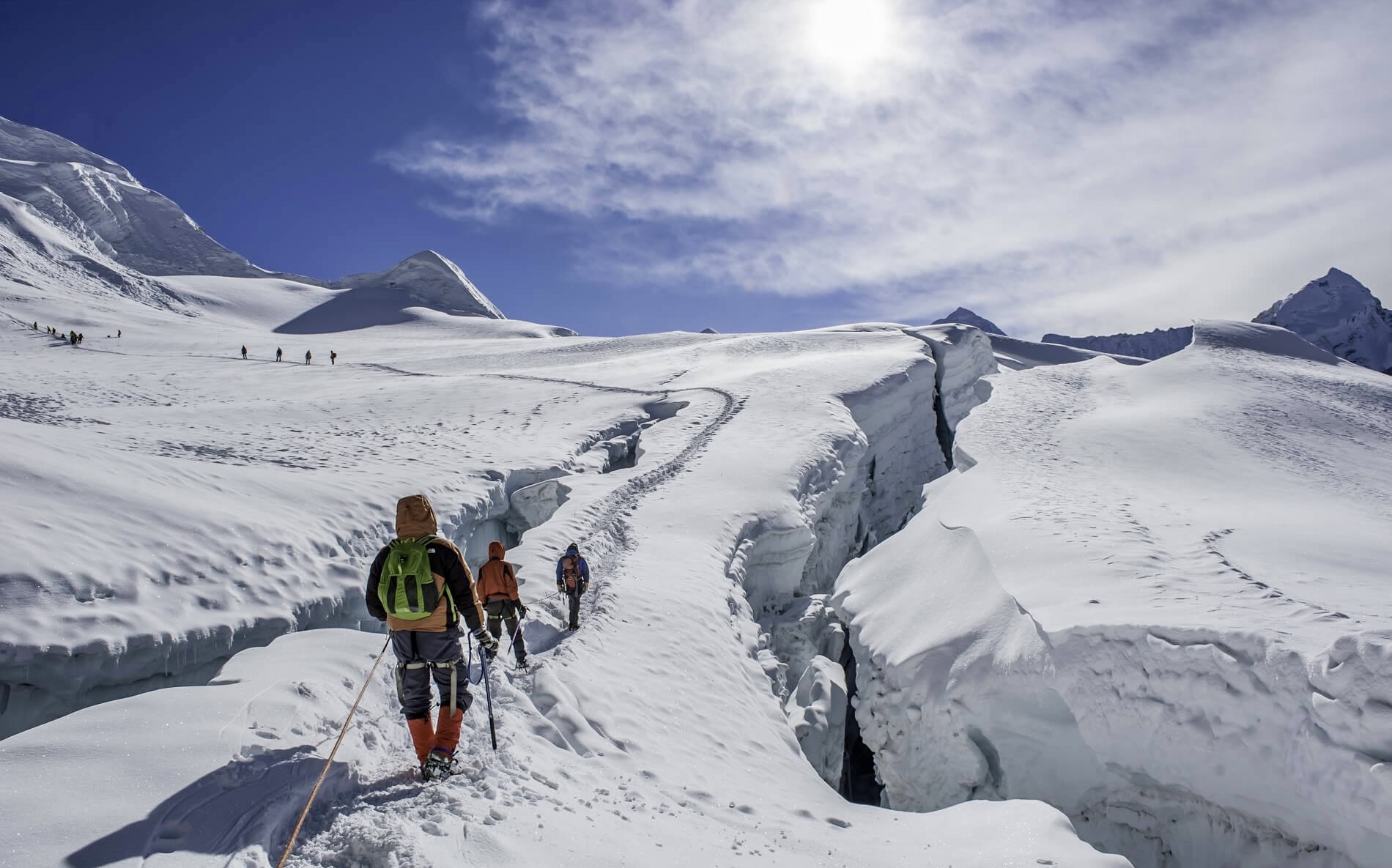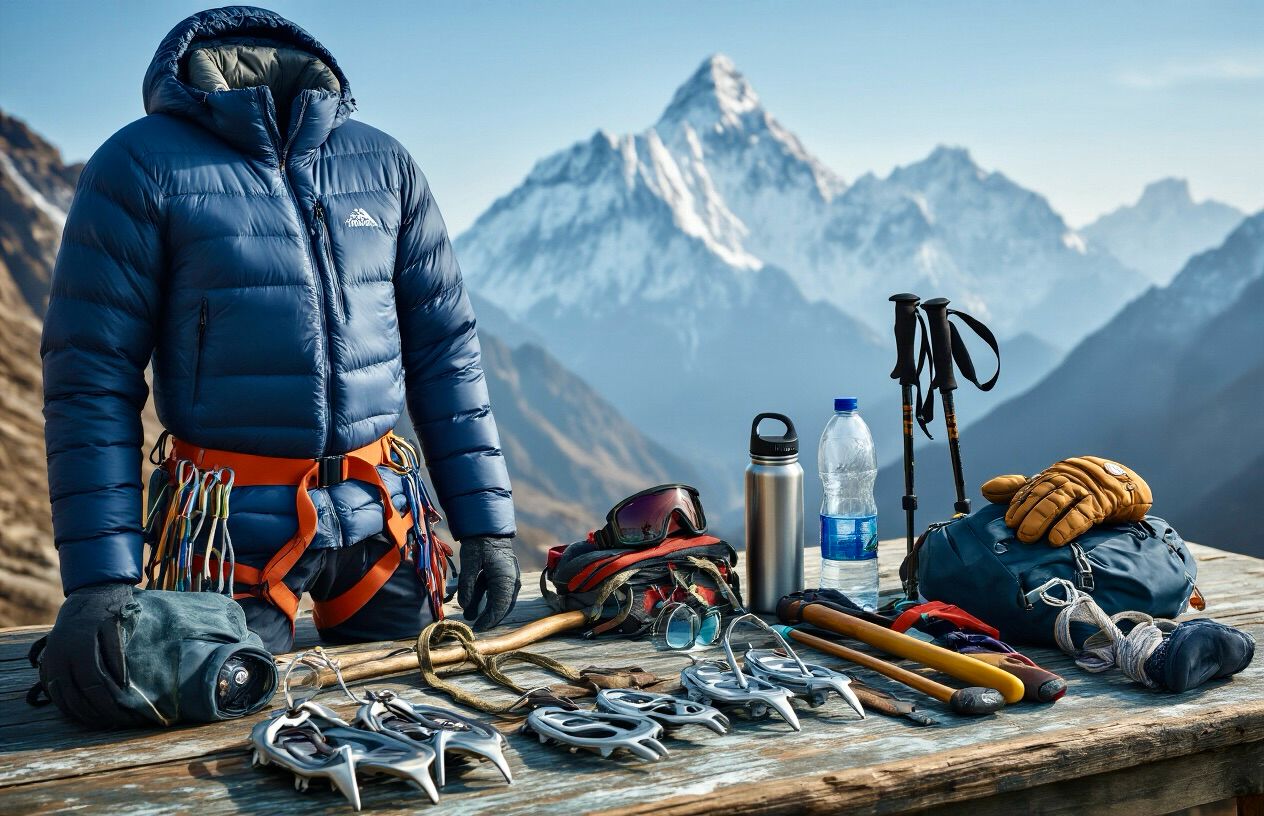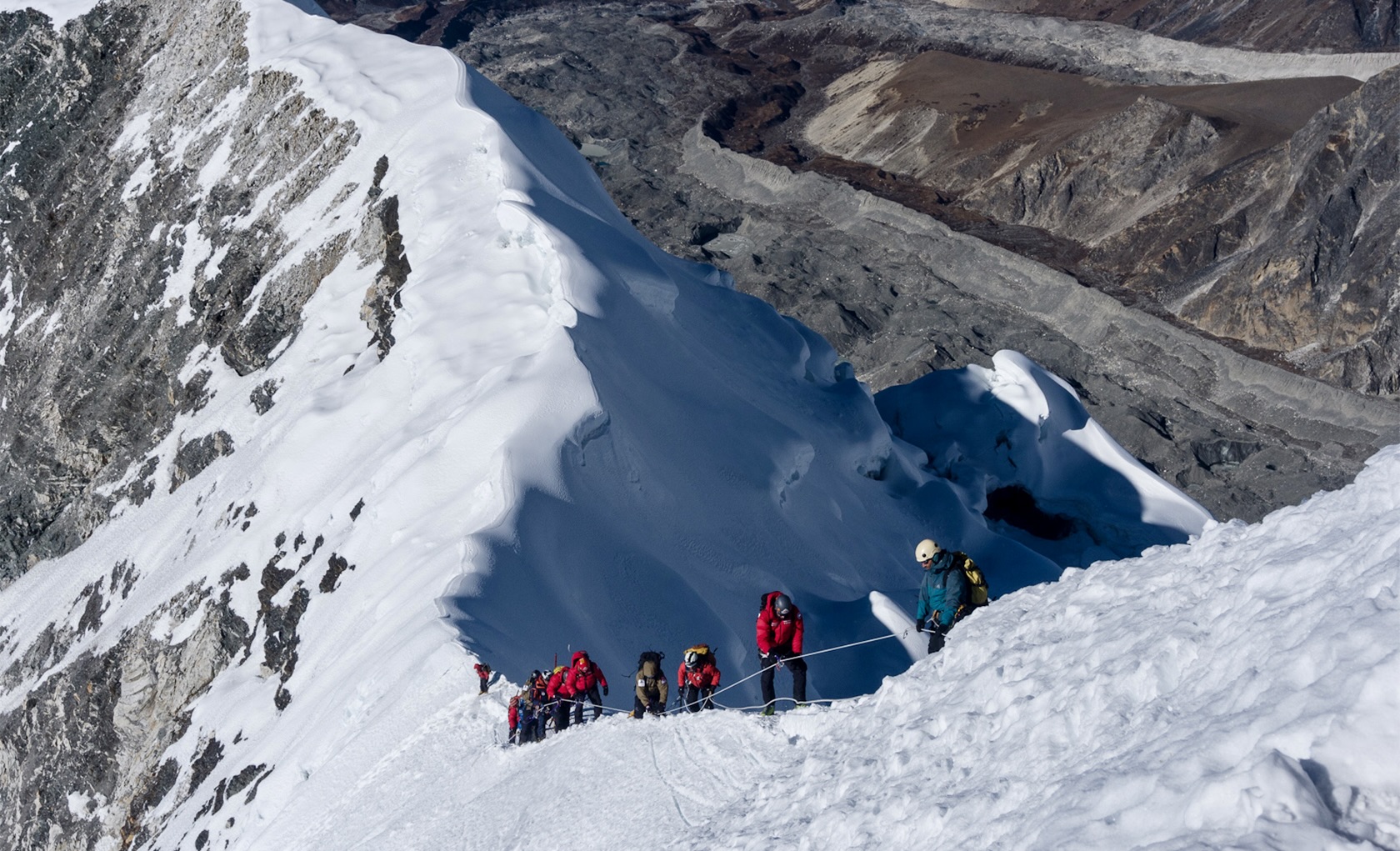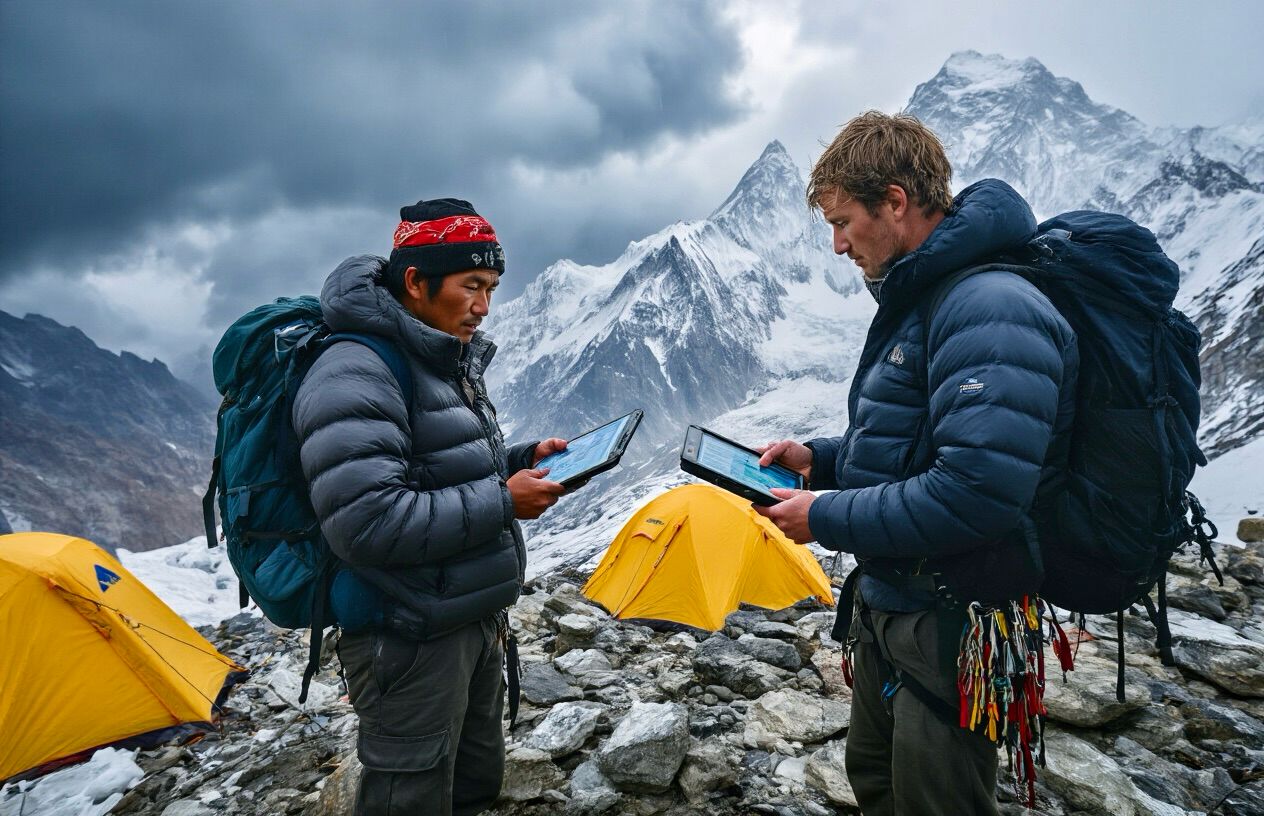Standing tall at 6,189 meters (20,305 feet) in Nepal's Khumbu region, Island Peak offers both beginners and seasoned mountaineers an exhilarating Himalayan climbing experience. This guide by Everest Sherpa Expeditions provides everything you need to know about conquering this popular trekking peak.
Whether you're taking your first steps into high-altitude mountaineering or looking to build experience for higher Himalayan summits, Island Peak (Imja Tse) delivers the perfect balance of challenge and accessibility. You'll find detailed information on physical preparation, technical requirements, and what to expect on the mountain.
In this guide, we'll cover essential preparation strategies for climbers of all levels, walk you through the classic climbing route from base camp to summit, and explain how working with experienced Sherpa guides can maximize your safety and success on the mountain. Let's get you ready for one of Nepal's most rewarding climbing adventures.
Understanding Island Peak: Essential Information for Climbers
Peak Statistics and Location Details
Island Peak, officially known as Imja Tse, stands at an impressive altitude of 6,189 meters (20,305 feet) in the Khumbu region of Nepal. Located in the Sagarmatha National Park, this peak is part of the greater Himalayan range and sits in the Imja Valley, just a few kilometers from the iconic Mount Everest. The mountain earned its nickname "Island Peak" from members of the 1953 British Everest Expedition who observed that it resembles an island in a sea of ice when viewed from Dingboche.
The peak is surrounded by the imposing Lhotse Face to the north and the rugged Amphu Laptsa pass to the south. Its proximity to Everest Base Camp makes it a popular choice for acclimatization before attempting higher peaks or as a standalone climbing achievement.

Climbing Difficulty and Technical Requirements
Island Peak is classified as a "trekking peak," but don't let this designation fool you. The climb presents moderate technical challenges with a difficulty rating of Alpine Grade PD+ (Peu Difficile Plus). Climbers will encounter various terrains, including:
- Steep snow and ice slopes (up to 45-50 degrees)
- A narrow ridge traverse
- A challenging headwall requiring fixed rope techniques
- A final summit ridge requiring good balance and concentration
Technical skills required include:
- Basic crampon and ice axe techniques
- Ability to use jumars (ascending devices)
- Knowledge of fixed rope techniques for ascending and rappelling
- Experience with glacier travel and crevasse navigation
While previous mountaineering experience is beneficial, Island Peak is considered an excellent first Himalayan climb for those with basic alpine skills and proper preparation.
Best Climbing Seasons and Weather Conditions
Island Peak has two primary climbing seasons:
Pre-monsoon (Spring: March to May)
- Gradually warming temperatures
- More stable weather conditions by April and May
- Clearer mornings but increasing cloud cover in the afternoons
- Blooming rhododendron forests during the approach trek
Post-monsoon (Autumn: September to November)
- Typically, clearer skies and excellent visibility
- Stable weather patterns
- Cooler temperatures
- Less precipitation than the spring season
Winter climbing (December-February) is possible but challenging due to extreme cold and potential heavy snowfall. The summer monsoon season (June-August) is generally avoided due to heavy precipitation, poor visibility, and increased risk of avalanches.
Permit Requirements and Regulations
All climbers attempting Island Peak must obtain:
- Island Peak Climbing Permit: Issued by the Nepal Mountaineering Association (NMA)
- Spring season: $250 per person
- Autumn season: $250 per person
- Winter/Summer seasons: $125 per person
- Sagarmatha National Park Entry Permit: Approximately $30 per person
- TIMS Card (Trekkers' Information Management System): $10 per person
Additional regulations include:
- Mandatory liaison officer for groups (though this requirement is sometimes waived for smaller groups)
- Proper waste management and environmental protection measures
- Prohibition of solo climbing without guides (as per recent regulations)
- Required climbing insurance with helicopter evacuation coverage
All permits can be arranged through registered trekking agencies in Kathmandu, which is highly recommended for a smooth expedition experience. Everest Sherpa Expeditions Pvt. Ltd. handles all necessary paperwork to ensure your climbing journey meets all legal requirements.
Physical and Technical Preparation for Island Peak
Required Fitness Level and Training Regimen
Island Peak (Imja Tse) at 6,189 meters (20,305 feet) demands excellent physical conditioning. Begin your training program at least 3-4 months before your expedition. Focus on:
- Cardiovascular Endurance: Dedicate 4-5 days weekly to activities like hiking, running, cycling, or swimming. Gradually increase duration to 1-2 hours per session.
- Strength Training: Include 2-3 weekly sessions targeting leg muscles (squats, lunges), core stability, and upper body strength for managing ropes and equipment.
- Hiking with Weight: Practice with a loaded backpack (10-15kg) on weekend hikes, gradually increasing elevation gain and distance.
- Stair Training: Climb stairs with a weighted pack to simulate ascent conditions.
- Interval Training: Incorporate high-intensity intervals to prepare for the demanding sections of the climb.
For optimal results, simulate climbing conditions by training at higher elevations when possible.
Essential Mountaineering Skills and Experience
Before attempting Island Peak, climbers should develop and practice:
- Crampon Technique: Master walking on varied snow and ice terrain.
- Ice Axe Use: Learn self-arrest techniques and proper axe handling.
- Fixed-Line Navigation: Practice ascending and descending using fixed ropes with ascenders and descenders.
- Rope Team Travel: Understand rope management and team movement techniques.
- Crevasse Rescue: Familiarize yourself with basic rescue procedures.
- Knot Tying: Master essential mountaineering knots for safety and equipment setup.
Previous experience on smaller peaks (4000-5000m) is highly recommended. Consider taking a basic mountaineering course if you're new to technical climbing.
Equipment and Gear Checklist

For a successful Island Peak expedition, ensure you have:
Technical Gear:
- Climbing harness and helmet
- Crampons (12-point, compatible with your boots)
- Ice axe (55-65cm recommended)
- Carabiners (2 locking, 2 non-locking)
- Ascender and descender devices
- Prusik cords and slings
Clothing Layers:
- Base layers (moisture-wicking)
- Mid layers (fleece/down)
- Outer shell (waterproof/windproof jacket and pants)
- Down jacket (800+ fill power)
- Insulated mountaineering pants
- Climbing gloves and mittens (multiple pairs)
- Balaclava and a warm hat
Footwear:
- 6000m-rated mountaineering boots
- Hiking boots for the approach
- Camp shoes
Other Essentials:
- Expedition-rated sleeping bag (-20°C/-4°F)
- Headlamp with extra batteries
- UV-protection sunglasses (Category 4)
- High SPF sunscreen and lip protection
- Personal first aid kit
- 2 water bottles (insulated)
- Trekking poles
Acclimatization and Altitude Preparation
Proper acclimatization is crucial for Island Peak success and safety:
- Gradual Ascent: Follow the "climb high, sleep low" principle during your approach trek.
- Hydration: Drink 4-5 liters of water daily to combat altitude effects.
- Rest Days: Include mandatory acclimatization days at Namche Bazaar (3,440m) and Dingboche (4,410m).
- Medication: Consult your physician about Diamox (Acetazolamide) for the prevention of altitude sickness.
- Monitoring: Learn to recognize altitude illness symptoms and communicate honestly with your guides about how you're feeling.
- Pre-Expedition Preparation: Consider sleeping in a hypoxic tent system before your trip if available.
A typical acclimatization schedule spans 8-10 days before attempting Island Peak, allowing your body to adapt gradually to the decreasing oxygen levels.
Planning Your Island Peak Expedition
Planning a successful climb of Island Peak requires careful consideration of various factors, from choosing the right support team to managing your budget effectively. This section will guide you through the essential aspects of expedition planning.
Choosing Between Guided and Independent Climbing
When preparing for Island Peak, your first major decision is whether to join a guided expedition or attempt an independent climb.
Guided Expeditions:
- Professional leadership from experienced mountaineers familiar with the terrain
- Complete logistics management, including permits, transportation, and accommodation
- Technical support with equipment and safety protocols
- Built-in support team of porters and high-altitude Sherpa guides
- Structured acclimatization schedule based on proven patterns
Independent Climbing:
- Greater flexibility with schedule and pace
- Potentially lower costs (though often offset by equipment rentals)
- Requires significant personal experience in high-altitude mountaineering
- Responsibility for all permit arrangements and logistics
- Need to source your support team locally
For beginners, guided expeditions through Everest Sherpa Expeditions provide the safest and most educational experience, while experienced climbers might prefer the autonomy of independent climbing with minimal support.
Duration and Itinerary Options
Island Peak expeditions typically range from 14-21 days when combined with Everest Base Camp treks.
Consider these common itinerary options:
Standard 16-Day Itinerary:
- 8-9 days trekking to Island Peak Base Camp via Everest Base Camp
- 2-3 days for acclimatization and technical training
- 1-2 days for summit attempt
- 3-4 days return journey
Extended 20-Day Itinerary:
- Additional acclimatization days
- More comprehensive technical training
- Buffer days for weather delays
- Possible side treks to Chhukung Ri or Kala Patthar
Your physical condition, previous altitude experience, and available time will determine the most suitable itinerary length. Shorter expeditions carry higher risks of altitude-related issues.
Cost Breakdown and Budget Planning
A comprehensive Island Peak expedition typically includes:
Essential Costs:
- Climbing permits ($250-400)
- National park fees ($30-50)
- Guide fees ($1,500-2,500 for certified guides)
- Porter wages ($25-35 per day per porter)
- Accommodation in teahouses ($10-30 per night)
- Food during the trek ($25-35 per day)
- Equipment rental if needed ($200-400)
- Transportation to/from Lukla ($350-500)
Additional Considerations:
- Travel insurance with high-altitude coverage ($150-300)
- Emergency evacuation coverage
- Personal gear purchases
- Tips for guides and porters (10-15% of trip cost)
- Contingency funds for unexpected expenses
Total expedition costs typically range from $3,000-6,000, depending on services included and expedition length.
Travel and Logistics Arrangements
Pre-Expedition Logistics:
- Secure necessary visas for Nepal (available on arrival for most nationalities)
- Book flights to Kathmandu at least 3 months in advance
- Arrange domestic flights to Lukla (often handled by expedition companies)
- Complete medical check-ups and necessary vaccinations
- Secure comprehensive travel insurance with helicopter evacuation coverage
Local Transportation:
- Kathmandu to Lukla flights (weather-dependent)
- Alternative overland routes via Jiri or Salleri if flights are canceled
- Porter and yak services for equipment transport during the trek
Accommodation Planning:
- Pre/post expedition stays in Kathmandu
- Teahouse accommodation during the approach trek
- Camping facilities at higher elevations and the base camp
Planning at least 6 months ensures the availability of quality guides and accommodation during peak seasons (March-May and September-November).
The Island Peak Climbing Route

Base Camp Approach and Trekking Route
The journey to Island Peak begins with a scenic trek through the Khumbu region. Most expeditions start from Lukla after a short flight from Kathmandu. The trekking route follows the classic Everest Base Camp trail through charming Sherpa villages like Phakding and Namche Bazaar, allowing for proper acclimatization.
From Namche, the trail continues to Tengboche with its famous monastery, then to Dingboche, where many groups spend 1-2 days acclimatizing further. The route then diverts from the main Everest trail at Dingboche, heading toward the Imja Valley and eventually to Island Peak Base Camp at approximately 5,087m (16,690ft).
Technical Climbing Sections and Challenges
Island Peak presents several technical challenges that require proper skills and equipment. After Base Camp, climbers tackle the initial rocky scramble to High Camp. From there, the route involves navigating a mix of terrain:
- Scrambling section: The initial climb involves rocky terrain requiring careful footing
- Glacier travel: Crossing the crevassed glacier requires rope team skills
- Headwall: A 100-meter (approximately 330ft) 45-50 degree snow and ice slope that requires fixed ropes and proper crampon technique
- Ridge traverse: The exposed summit ridge requires focus and proper clipping techniques on fixed lines
The most challenging section is typically the headwall, where climbers must use jumars (ascending devices) on fixed ropes while maintaining proper crampon technique on the steep slope.
Camp Locations and Rest Points
The expedition typically includes these key stopping points:
- Lukla (2,860m/9,383ft): Starting point after flying from Kathmandu
- Namche Bazaar (3,440m/11,286ft): Important acclimatization stop
- Dingboche (4,410m/14,469ft): Last major settlement before Base Camp
- Island Peak Base Camp (5,087m/16,690ft): Main staging area for the climb
- High Camp (5,600m/18,372ft): Optional camp that shortens summit day
Some expeditions skip High Camp and attempt the summit directly from Base Camp, making for a longer but logistically simpler summit day.
Summit Day Strategy and Timeline
Summit day typically begins between midnight and 2:00 AM to ensure climbers reach the summit early and descend before afternoon weather deteriorates. A typical summit day timeline:
- 12:00-2:00 AM: Departure from High Camp (or earlier from Base Camp)
- First light: Ideally, reaching the glacier crossing
- Sunrise: Beginning the technical sections on the headwall
- 9:00-11:00 AM: Summit window (6,189m/20,305ft)
- Early afternoon: Complete descent to Base Camp
Climbers should maintain a steady, sustainable pace throughout the climb, keeping energy reserves for the technical sections and the long descent. Most expedition leaders enforce turnaround times to ensure safe returns before weather conditions potentially worsen in the afternoon.
Safety Considerations and Risk Management
Common Hazards and Risk Assessment
Island Peak climbing presents several significant hazards that all climbers must be aware of before attempting this challenging 6,189m summit. The primary risks include altitude sickness (AMS, HAPE, HACE), crevasse falls on the glacier section, avalanche danger (particularly during or after heavy snowfall), extreme weather conditions that can develop rapidly, and physical exhaustion due to the demanding nature of the climb.
Before embarking on your expedition, conduct a thorough personal risk assessment. This includes evaluating your fitness level, technical climbing experience, and acclimatization plan. Monitor weather forecasts daily and consult with your Sherpa guides about current mountain conditions. Remember that knowing when to turn back is crucial—summit fever has contributed to many mountaineering accidents.
Emergency Procedures and Evacuation Plans
Everest Sherpa Expeditions implements comprehensive emergency response protocols for all Island Peak climbs. Our standard procedure includes immediate first aid administration by trained guides, communication with base camp operations, and activation of evacuation procedures when necessary.
Helicopter evacuation is available in most weather conditions from Island Peak Base Camp. However, be aware that evacuations from higher on the mountain may be delayed by weather. Our team carries portable hyperbaric chambers (Gamow bags) for temporary treatment of severe altitude sickness until evacuation is possible.
Each climbing group follows established check-in protocols, with mandatory radio contact at designated times. This ensures a rapid response if a team fails to report.
Insurance Requirements and Coverage
All climbers must obtain specialized mountaineering insurance before joining an Island Peak expedition. Your policy must explicitly cover:
- High-altitude trekking and climbing up to 6,500m
- Helicopter evacuation and rescue operations
- Emergency medical treatment and repatriation
- Coverage value of at least USD 100,000
Standard travel insurance typically does not cover mountaineering activities. We recommend providers specializing in adventure sports such as World Nomads, Global Rescue, or the BMC. Verify your policy details carefully, as some exclude certain technical climbing activities or have altitude limitations.
Communication and Safety Equipment
Every Island Peak expedition requires essential safety and communication equipment:
- Satellite phones and two-way radios for emergency communication
- GPS devices with pre-loaded routes and waypoints
- Personal locator beacons for emergency signaling
- Comprehensive first aid kits, including altitude medications
- Technical rescue equipment, including ropes, harnesses, carabiners, and pulleys
Our Sherpa guides maintain regular communication with base camp and Kathmandu operations using satellite technology. Each climbing team is equipped with backup communication systems in case primary devices fail.
All climbers receive training in the use of safety equipment during pre-climb briefings, including oxygen administration, radio protocols, and basic rescue techniques. This preparation is essential for creating a safer climbing environment where all team members can assist in emergencies.
Working with Sherpa Guides and Support Teams

Benefits of Professional Sherpa Guidance
The Sherpa people of Nepal have earned worldwide recognition for their extraordinary climbing abilities. Their expertise is exemplified by remarkable individuals like Ang Rita Sherpa, who successfully summited Mount Everest an impressive 10 times. This illustrates the unparalleled skill and experience that Sherpa guides bring to climbing expeditions. When attempting Island Peak, partnering with professional Sherpa guides provides access to generations of mountaineering knowledge that cannot be found in any guidebook or training course.
For many Sherpas, mountaineering isn't just a passion—it's their livelihood and profession. Their intimate familiarity with the Himalayan terrain, weather patterns, and climbing routes makes them invaluable partners for both beginner and experienced climbers tackling Island Peak.
Cultural Understanding and Respect
The Sherpa culture represents a unique blend of local Buddhist traditions, animist beliefs, and cultural practices that have evolved over centuries in the high Himalayan environment. These traditions have significantly shaped how Sherpas interact with Western climbers and approach mountaineering activities.
When working with your Sherpa team on Island Peak, demonstrating respect for their cultural perspectives creates a more harmonious expedition experience. Understanding that Sherpas may perform certain rituals or observe specific practices before and during climbs acknowledges the deep spiritual connection they maintain with the mountains.
Team Dynamics and Communication
The relationship between Western climbers and Sherpas has historically been complex and continues to evolve. Effective communication is essential for building trust and ensuring safety during your Island Peak expedition. Remember that your Sherpa guides bring not only technical expertise but also a different worldview shaped by their unique cultural heritage.
Creating positive team dynamics involves recognizing the professional capabilities of your Sherpa guides while appreciating the cultural differences that might influence communication styles and decision-making processes.
Porter and Support Services
Beyond guide services, Sherpas often provide comprehensive support through porter services that are crucial for Island Peak expeditions. This aspect of mountaineering represents a significant source of income for many in the Sherpa community.
The support team will typically handle logistics, including equipment transport, camp setup, and meal preparation, allowing climbers to focus on the physical and mental challenges of the ascent. The efficiency and reliability of these services stem from the Sherpas' generations of experience working in high-altitude environments and their cultural adaptation to these demanding conditions.
Post-Climb Recovery and Next Steps
Descent Strategy and Safety Protocols
After successfully summiting Island Peak, a careful descent is crucial for your safety. The journey down can often be more hazardous than the ascent due to fatigue and decreased focus. Always maintain rope connections with your team during the initial steep sections. Your Sherpa guides from Everest Sherpa Expeditions will ensure proper anchoring systems are in place for rappelling down technical segments.
Stay hydrated and maintain regular communication with your team members. Weather conditions can change rapidly, so continuous monitoring is essential. Take regular breaks but avoid lingering too long at high altitudes. The descent route follows the same path as your ascent, passing through High Camp and Base Camp, where you'll gradually acclimate to lower elevations.
Physical Recovery and Health Monitoring
Once back at Base Camp, your body needs time to recover from the significant exertion. The first 24-48 hours are critical for monitoring any altitude-related symptoms that might develop even during descent. Everest Sherpa Expeditions' guides are trained to recognize signs of altitude sickness, dehydration, and exhaustion.
Prioritize rehydration with electrolyte-rich fluids and consume calorie-dense meals to replenish energy stores. Allow yourself to rest adequately before beginning the trek back to Lukla. During your recovery period, gentle stretching can help alleviate muscle soreness and prevent stiffness.
Celebrating Success and Achievement
Reaching the summit of Island Peak is a significant achievement worthy of celebration. Many climbers participate in a small ceremony at Base Camp, where Everest Sherpa Expeditions typically arranges a special meal with the entire support team. This is an excellent opportunity to thank your Sherpa guides and porters who made your success possible.
Document your experience through photographs and journal entries while memories are fresh. Share your stories with fellow climbers and learn from their experiences as well. This camaraderie is an essential part of the mountaineering tradition and enhances your overall expedition experience.
Planning Advanced Climbing Objectives
With Island Peak (6,189m) under your belt, you've gained valuable high-altitude experience that serves as an excellent foundation for more challenging climbs. Many climbers progress to peaks like Mera Peak (6,476m), Lobuche East (6,119m), or even consider expedition peaks like Ama Dablam (6,812m).
Everest Sherpa Expeditions can guide suitable progression paths based on your performance, technical skills, and personal goals. Consider investing in advanced mountaineering courses to refine your technical skills before attempting more difficult objectives. Each climb builds upon your experience, gradually preparing you for increasingly challenging mountains in Nepal and beyond.
Maintain your fitness level after returning home by incorporating specific training regimens that address any weaknesses identified during your Island Peak climb. The relationships formed with guides and fellow climbers often become valuable connections for planning future expeditions.
Embrace the Adventure of Island Peak
As you prepare for your Island Peak expedition, remember that success on this magnificent Himalayan peak requires careful planning, proper physical and technical preparation, and respect for the mountain environment. Whether you're a beginner taking your first steps into high-altitude mountaineering or an experienced climber seeking a new challenge, Island Peak offers a perfect blend of accessibility and adventure that has made it a beloved destination in the Everest region.
The journey doesn't end when you descend from the summit. Take time to recover properly, reflect on your achievement, and perhaps begin planning your next Himalayan adventure. By climbing with experienced Sherpa guides from Everest Sherpa Expeditions Pvt. Ltd., you'll not only increase your chances of a successful summit but also gain invaluable insights into the rich cultural heritage and mountaineering traditions of the region. Island Peak isn't just a mountain to climb—it's an experience that will transform your perspective on what's possible in the world of high-altitude mountaineering.
If you need any further information, please contact us by email: [email protected], Phone: +977- 980 195 6248 (WhatsApp).


